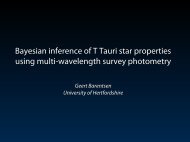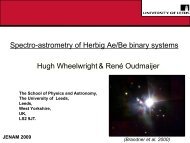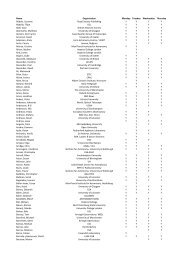John Barnes - Centre for Astrophysics Research (CAR) - University ...
John Barnes - Centre for Astrophysics Research (CAR) - University ...
John Barnes - Centre for Astrophysics Research (CAR) - University ...
Create successful ePaper yourself
Turn your PDF publications into a flip-book with our unique Google optimized e-Paper software.
Red Optical Planet Survey (R PS):A radial velocity search <strong>for</strong> low massM dwarf planets<strong>John</strong> <strong>Barnes</strong><strong>Centre</strong> <strong>for</strong> <strong>Astrophysics</strong><strong>Research</strong><strong>University</strong> of Hert<strong>for</strong>dshireUKCollaborators:H. Jones, D. Pinfield, M. Tuomi(<strong>University</strong> Of Hert<strong>for</strong>dshire, UK)James Jenkins, Patricio Rojo(Universidad de Chile)Andrés Jordán, Dante Minniti, PamelaArriagada, (Universidad Católica de Chile)S. Jeffers (Göttingen)
The holy grail of exoplanet hunting –Earth-mass planetsNearest stars vs stars with detected planetsRECONS 2012(www.chara.gsu.edu/RECONS)73% M dwarfsNumber of planets by host star massM dwarfsK, G, F, A dwarfs
• Kepler planet candidates:M dwarf planet frequenciesEarth/super-Earth size planets~3–4 x more numerous around Mstars than earlier spectral types(Borucki et al. 2011)• Found in greater numbers thantransiting Jupiter size planetsorbiting earlier spectral types• Many of these candidates are inclose orbits < 0.1 AU.• Dressing & Charbonneau (2013,A&A. 767, 95) estimate0.04occurrence rates of 0.9 ± 0.03 <strong>for</strong>M dwarf Kepler transitcandidates with 0.5 – 4 R andP < 50 dBorucki et al.2011
M dwarf planet frequencies• HARPS early-mid M dwarf sample (Bonfils et al., 2013, 549, 109)Frequency 100-1000 M 1-10 M P = 1 - 10 d ≤0.01 0.36 ±0.030.01P = 10 - 100d 0.02 ± 0.52 ±0.250.100.500.16• At least 25% of early M dwarfs should harbour Earth-mass(1-10 M ) planets in short period orbits!• ....but may be as high as 100% !!Freq. of M dwarf HZ planets, = 0.41 ± (i.e. 28% - 95%) !!!Next talk (Mikko Tuomi)0.540.13
VisibleRed opticalNear infrared Y-bandSo many M dwarfs - why so few M dwarfplanets….?M6 SpectrumAdapted from Pavlenko et al. 2006M4V – M9VRed-optical : V – I ~ 2.5 - 5Near infrared : V - J ~ 5 - 8Pavlenko et al. 2006
Recent results• CRIRES/VLT: Infrared K-band using a NH 3 gas cell has achieved~5ms -1 (Bean et al. 2010) using 364 Å of spectrumProx Cen = 5.4 ms -1 (binned, ½ yr)S/N=160• Keck/NIRSPEC – 1.25 m R~20,000 (4 orders 150-200 Å)Tellurics as reference Precision = 180 – 300 ms -1No evidence <strong>for</strong> planets around 8 M dwarfs (Rodler et al. 2012,A&A, 538, 141)• Keck/NIRSPEC : 50 ms -1 precision using tellurics (K band)20 young stars in -Pic and TW Hya (77 ms -1 limited by starspots).Hot/warm Jupiters excluded (Bailey et al. 2012, ApJ, 749, 16)
RV sensitivity in the red-optical• RO spectral in<strong>for</strong>mation 0.65 – 1.05m region (M6 spectrum – red)• Atmospheric O 2 and H 2 O lines(green)• SED (incl. MIKE & CCD response) <strong>for</strong>typical M5.5V & M9V dwarfs.• Red optical and HARPS region fluxes:F 0.7-0.9 /F 0.5-0.7 = 11.5 (M5.5V) and 19 (M9V)(based on MIKE instr & CCD)
Stability with tellurics as a reference fiducial• Tellurics stable to 10 ms -1 over6 years in HARPS data and to~2-6 ms -1 over week timescalesFigueira et al. (2010)
Deconvolution S/N in a single spectrum is typically of order a few to to a few hundred Several hundred to several thousand lines in a typical spectrum Use model spectrum to deconvolve mean profile from observed spectra A weighted least squares profile is derived, with high S/N ratio governed bythe number of lines (typically factor of a few x10 gain in S/N)GJ 1002(M5.5V)S/N ratios of order ~1000+ can be achieved <strong>for</strong> a single spectrum,enabling radial velocities with high precision to be determined
Magellan/MIKE M5.5V-M8V dwarfs<strong>Barnes</strong> et al., 2012, MNRAS, 424, 591 Observation pair r.m.s in good agreement with cross-corr. errors 10 and 6 signals <strong>for</strong> GJ 3128 and SOJ0253+1653 GJ 3128: P = 0.51 d, K * = 209.4 m/s – m p sin i = 3.3 M Nep SO J0253+1653: P = 2.1 d, K * = 182.7 m/s -- m p sin i = 4.9 M NepAre there significant noise sources yet unaccounted <strong>for</strong>?
Proxima Centauri – a training dataset Archival UVES data from 2009 March 10, 12 & 14 taken as a simultaneouswavelength monitoring programme (Fuhermeister, 2010) Blue/Red Arm (0.4 – 1.1 m) Resolution 40,000 – 1´´ slit = 7.4 ms -1= 7.2 (am > 1.5)
Proxima Centauri Archival UVES data from 2009 March 10, 12 & 14 taken as a simultaneouswavelength monitoring programme (Fuhermeister, 2010) Blue/Red Arm (0.4 – 1.1 m) Resolution 40,000 – 1´´ slit = 8.2 ms -1= 8.1 (am > 1.5)
Proxima Centauri Archival UVES data from 2009 March 10, 12 & 14 taken as a simultaneouswavelength monitoring programme (Fuhermeister, 2010) Blue/Red Arm (0.4 – 1.1 m) Resolution 40,000 – 1´´ slit = 9.0 ms -1= 7.7 (am > 1.5)
Continuing ROPS with UVESFour half nights on UVES/VLT – 2013 July 22-28Advantages of UVES:- Better order separation- Wavelength coverage 0.64 - 1.03 m (MIKE: 0.62 – 0.89 m)- Improved resolution R~50,000 (MIKE: 35,000)- ~1200 m/s/pixel (MIKE: 2150 m/s/pixel)- Parallactic angle maintained during observations2012 July 23
Poisson limited precision usingdeconvolution method? Synthetic spectra telluric & spectral lines deconvolve <strong>for</strong>spectra with S/N scaled to 15,30,60,120,240.MC simulation to obtain mean scatter.e.g. S/N = 120 ~3 m/s (MIKE/Magellan), ~2 m/s (UVES/VLT)
ROPS RVs <strong>for</strong> eight M5.5-M8 dwarfs• 4 epochs spread over 6 nights: 5.1 – 18.6 ms
Sensitivities• For UVES - 5 ms -1 - 1, 2, 3- K* sensitivities3,6,9 M at M6V2,4,6 M at M9V
ROPS parameter spaceROPS2- upperlimits10 M 1 M • Lowest mass M dwarf RVS• HZ 2- upper limits of 5.7 – 14.5 M • Rocky planet sensitivities should be achieved <strong>for</strong> M6V – M9V targets
Summary• Initial 2 night study of 7 mid-late M dwarfs with MIKE: 10 ms -1precision on brightest / most stable targets• UVES survey of 14 mid-late M dwarfs - 4 nights with 6 nightbaseline: RV precisions of ~5 - 19 ms -1 achieved on 8 targets (6further targets yet to be fully analysed)SP Typer.m.s sensitivity (HZ)M5.5V - M6.5V 2.9 M – 7.8 M (11 M )M7V – M9V4.6 M – 5.6 M • Exclude BD companions (M 13 M J ) in 6/12 day orbits(0.03/0.05 AU, K * 6.7/5.2 kms -1 )0.25( BD desert: 0.0 0.10% of M stars with L companions @ 5-70 AUDieterich et al, 2012 )• Four half nights pending (MIKE) in Oct / Nov 2013 – extendobservations to 8 – 10 epochs





